Throughout
history, cases of man's inhumanity to his fellow man abound. The
German Holocaust is known and condemned by all. Public outcry is
long and loud over newer
instances such as the
Bosnian genocide.
The United States is not free from guilt. The tragedy of "The Trail
of Tears" cries for remembrance throughout the ages. Although not as
well publicized as some other instances of genocide, the Cherokee
Removal was American history's ultimate betrayal.
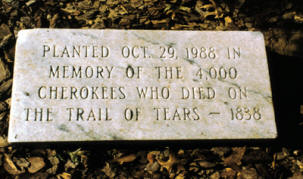 |
Marker commemorating those who died
on the
Trail of Tears |
Before it ended, 4,000 Cherokee lay dead. An entire nation was
dispersed never to be reunited again. One national American hero's
feet of clay were forever exposed and political hypocrisy and deceit
reached an all time high. The tiny site of New Echota near
Cartersville was the hub of it all. The Georgia State park situated
there today recreates the old Cherokee capital. The park musuem is
the perfect place to begin your tour of the Cherokee Trail in
Georgia.
In 1825,
New Echota was the heart and soul of the Cherokee Nation. By 1835, it was ghost
town. Fate and history linked all the actors in this tragic drama
before the final curtain fell on the Cherokee hopes and dreams and
arose on the opening of a new frontier for the white settlers.
was the heart and soul of the Cherokee Nation. By 1835, it was ghost
town. Fate and history linked all the actors in this tragic drama
before the final curtain fell on the Cherokee hopes and dreams and
arose on the opening of a new frontier for the white settlers.
 |
| Council
House at New Echota |
The villain of the piece seems clear.
Andrew Jackson , hero of the battle of New Orleans, long time Indian fighter and
finally president of the United States.
The hero is harder to see. Was it
John Ross
, hero of the battle of New Orleans, long time Indian fighter and
finally president of the United States.
The hero is harder to see. Was it
John Ross ,
Principal Chief of the Cherokee Nation? Was it
Sequoyah
,
Principal Chief of the Cherokee Nation? Was it
Sequoyah , the man who overnight made his people literate? Where does history
place
Elias Boudinot
, the man who overnight made his people literate? Where does history
place
Elias Boudinot ?
He edited the first Cherokee newspaper, The Phoenix. In just four
short years, his beliefs did a complete about face. Then there was
Major Ridge
?
He edited the first Cherokee newspaper, The Phoenix. In just four
short years, his beliefs did a complete about face. Then there was
Major Ridge ,
Chief of the Cherokee police, The Lighthorse Patrol, Counselor to
his good friend Chief John Ross and Speaker of the Council in the
Cherokee lower legislative house. And where did Elias' brother Stand
Watie fit in. When he helped the Georgia Militia destroy the Phoenix
printing press. Did he stomp the soft lead type into Georgia's red
clay in an effort to preserve the Cherokee heritage or to line his
pockets? What of the
supporting cast? History may have overlooked them but the drama of
the Trail of Tears would have been different were it not for their
contributions. Samuel Worcester and Junaluska‘s deeds are forever
interwoven in Georgia's history of this time.
,
Chief of the Cherokee police, The Lighthorse Patrol, Counselor to
his good friend Chief John Ross and Speaker of the Council in the
Cherokee lower legislative house. And where did Elias' brother Stand
Watie fit in. When he helped the Georgia Militia destroy the Phoenix
printing press. Did he stomp the soft lead type into Georgia's red
clay in an effort to preserve the Cherokee heritage or to line his
pockets? What of the
supporting cast? History may have overlooked them but the drama of
the Trail of Tears would have been different were it not for their
contributions. Samuel Worcester and Junaluska‘s deeds are forever
interwoven in Georgia's history of this time.
The drama had
its prelude when the first settlers, led by men like
Daniel Boone first looked upon the land of the Cherokee and coveted it for
themselves. The first act, bringing most of the main players
together began in the early 1800's.
first looked upon the land of the Cherokee and coveted it for
themselves. The first act, bringing most of the main players
together began in the early 1800's.
In 1814,
Jackson was ordered to stop the uprising of the Creek. The
culmination of the Creek War was the battle of Horseshoe Bend in
March of that year. Many of the Cherokee stood with him. Jackson
appointed Ridge "Major" .A title he would use as his name for the
remainder of his life. John Ross, Ridge's close friend, was a
lieutenant during that war. Sequoyah was another Cherokee who would
both fight under Jackson and also play a part in the drama that
would lead to The Trail of Tears. John Ross swam across the frigid
Tallapoosa River to steal the Cheek canoes, which were then used in
a diversionary, attract by the Cherokee. Ridge's canoe was the first
across the river on that fateful day.
Junaluska , another Cherokee warrior, is credited with saving Jackson's life
at that battle. Thus the Cherokee were shocked when after the war,
Jackson forced the Creek to sign over 22 million acres of land in
Southern Georgia and central Alabama of which a large part was
considered Cherokee land.
President James Madison sided with the Cherokee but just
months later, Jackson was successful in getting most of the land by
means of a treaty signed a group of chiefs, including Sequoyah, The
handwriting was on the wall. Whatever the Cherokee did to prove they
were loyal, law abiding people, however many times the courts upheld
their claim, their fate was sealed.
, another Cherokee warrior, is credited with saving Jackson's life
at that battle. Thus the Cherokee were shocked when after the war,
Jackson forced the Creek to sign over 22 million acres of land in
Southern Georgia and central Alabama of which a large part was
considered Cherokee land.
President James Madison sided with the Cherokee but just
months later, Jackson was successful in getting most of the land by
means of a treaty signed a group of chiefs, including Sequoyah, The
handwriting was on the wall. Whatever the Cherokee did to prove they
were loyal, law abiding people, however many times the courts upheld
their claim, their fate was sealed.
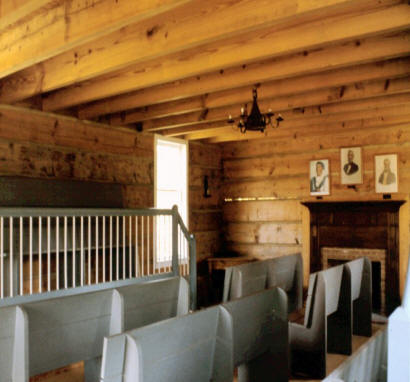 |
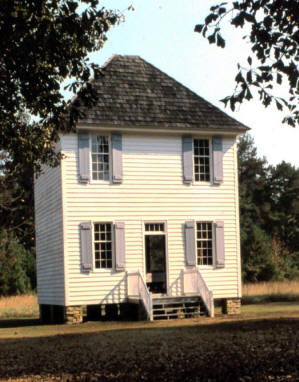 |
| The
enterior of the Cherokee Council House, similar to our
Senate. The portraits over the mantle are Chief George
Lowrey, Chief John Ross and Major Ridge |
The Cherokee
Supreme Court. The Cherokee had a form of government similar
to the U.S. |
In spite of
Jackson's treachery, Ridge and many of the Cherokee still supported
him throughout the Seminole War. In 1823 Jackson, who had earned his
nickname of "Old Hickory" for his toughness, was elected to the
Senate. He used this position as a stepping stone to the Presidency
in 1828. One of his first acts was the passing of the "Indian
Removal Act". Between 1814 and 1824, Jackson held a key role in
negotiating nine out of eleven treaties, which would force the
Native Americans off their ancestral land to less desirable land out
west.
Chief Junaluska
who had saved Jackson's life at Horseshoe Bend, went to plead with
Jackson for the protection of his people and was met with the reply:
"Sir, your audience is ended. There is nothing I can do for you".
Junaluska later
stated, "Oh my God, if I had known at the Battle of Horseshoe Bend
what I now know, American history would have been differently
written."
In 1819 the
Cherokee Council began holding their official meetings in Newtown, a
small community in Northwest Georgia. It was officially proclaimed
the Cherokee capital and its name changed to New Echota in 1825. By
1927, the Cherokee had established a form of government modeled
after the United States. They built civic building there to house
the seat of their government. By 1830, Cherokee surveyors had laid
out a well-planned community. It had a two-acre town square with a
60-foot wide main street. This was a small town of about fifty
permanent residents most of the year but when council meetings took
place, it was a buzzing hive of activity. Legislators arrived to
attend sessions in the upper or lower council house. Justices came
to sit in judgment in the city's Supreme Court Building. The poor
and the wealthy alike came to their capita city for a lawmaking
session and to enjoy a social get together. The indigent walked into
town. The wealthy Cherokees arrived in elegant carriages with their
elaborately gowned wives and daughters. Their sons rode besides them
on sleek horses. Their slaves attended to their needs much as the
denizens of Georgia's capital city, Milledgeville.
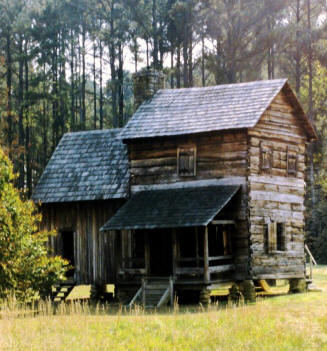 |
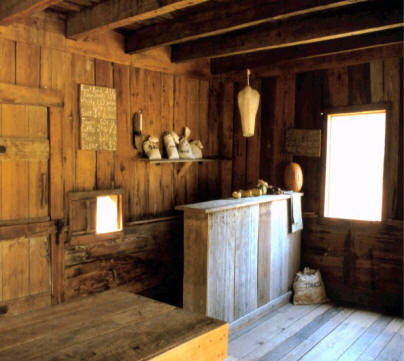 |
| Vann's Tavern at New Echota. This
is an original building that was moved to the state park. |
Vann's Tavern interior. In addition
to being planters,
the Vann's were sucessful business
men. |
One of the
wealthiest of the Cherokee was Rich Joe Vann. He lived in luxury on
his successful plantation built by his father, Chief James Vann. It
was the first brick house ever built by a Cherokee and shows a
marked Moravian influence in style and design. The centerpiece of
his home is the magnificent cantilevered staircase.
The doors, known as Christian doors, have features
representing a cross and an open Bible.
 |
 |
 |
The Vann House
(Credit all Vann
House Pictures to Martin Walls |
Famed cantilevered staircase in
Vann House |
Objects excavatred at the Vann
House |
Chief Vann's house also included a blacksmith shop, the 800-acre property around
the Vann House with 42 slave cabins, 6 barns, 5 smokehouses, a
trading post, more than 1,000 peach trees, 147 apple trees, and a
still.
house also included a blacksmith shop, the 800-acre property around
the Vann House with 42 slave cabins, 6 barns, 5 smokehouses, a
trading post, more than 1,000 peach trees, 147 apple trees, and a
still.
After
constructing The Vann House, James lived at the house for 5 years
before he was killed at Buffington's Tavern in 1809. After his death
he left the house to his favorite child, Rich Joe, who occupied it
until the Removal. It is another "must visit" to understand the
Cherokee heritage in Georgia.
If the city of
New Echota represented the pride of the Cherokee Nation, its voice
was The Phoenix, their national newspaper. Housed in a modest frame
building, The Phoenix bound the far-flung tribe together. The
Cherokee were the only Native Americans to have their own written
language. A young Cherokee named Sequoyah devised a Cherokee
alphabet in 1821. He had worked on the concept for 12 years and
finally developed a syllabary, which allowed any Cherokee speaker to
become literate in two weeks. The concept was called the "Talking
Leaves" by the Indians as a slur on the white man's use of the
written word. The Cherokees felt the white man's written words were
like the leaves that dried up and blew away when the words were no
longer suited.
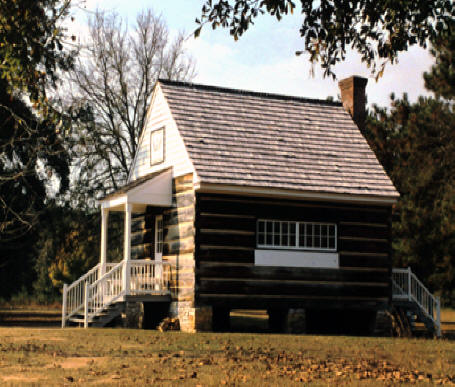 |
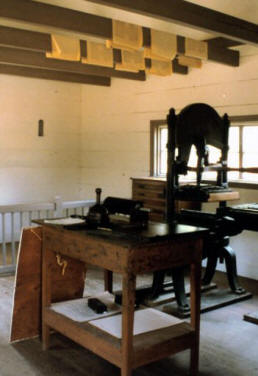 |
| Phoenix replica at New Echota |
Printing Press in Pheonix building |
This alphabet
led to the founding of the national paper in Feburary1828. Elias
Boudinot was a natural for the first editor. Born Gallegina (Buck)
Oowatie – the Oo was later dropped from the surname- he was educated
in Connecticut and traveled extensively throughout the east as a
young man. On his travels through Washington, young Buck met Dr.
Elias Boudinot, a statesman best known as having served a term as
President under the Articles of Confederation. A strong friendship
developed and Buck adopted the name of his mentor. As Elias
Boudinot, the young Cherokee was a staunch proponed of a national
paper and helped raise money for the project through speaking
engagements. Politically, at this time, he was a strong backer of
Chief John Ross's Nationalist Party. Elias and his new bride,
Harriet Gold of Connecticut, settled down in a small cabin just down
the street from the Phoenix office.
During his time
in Connecticut, Elias had developed a close friendship with Samuel
Worcester. Samuel was a seventh generation minister. He had a gift
for languages and knowledge of printing from his father who had
worked as a part time printer.
Elias asked Samuel to come to New Echota and help with the
development of the newspaper. Samuel and his wife also used their
mission connections to help fund The Phoenix. His Cherokee name, The
Messenger, reflects his great input into the paper until his death
in 1859 in the Oklahoma Territory.
Samuel and Ann's home was built near the outskirts of the
Cherokee capital and still stands today.
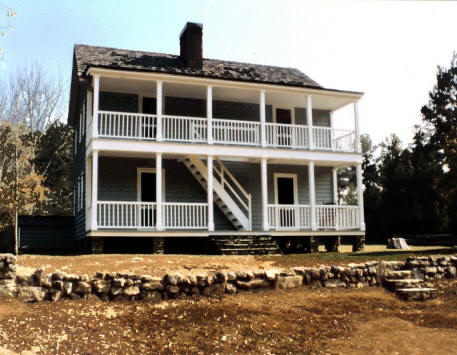 |
| Samuel Worchester's house. The only
building original to the site |
Another close
friend and cousin of Elias and his brother,
Stand Watie ,
was John Ridge, son of Major Ridge. Major Ridge came to see the West
as the only hope for his people to survive as a nation. Ironically,
both Elias and John Ridge supported the 1829 law that mandated the
death penalty for any Indian who signed away Cherokee land. However,
by 1832, Elias had converted to Major Ridge's Treaty Party that
advocated removal to Oklahoma. Even though the Supreme Court had
supported the Cherokees, President Jackson is reputed to have
stated, "John Marshall has made his decision. Now let him enforce
it." He probably was too clever a politician to have actually spoken
those words but they reflected his sentiments
and his actions accurately.
This is the same man who earlier promised John Ross that Cherokee
lands would be theirs "as long as the grass grows."
,
was John Ridge, son of Major Ridge. Major Ridge came to see the West
as the only hope for his people to survive as a nation. Ironically,
both Elias and John Ridge supported the 1829 law that mandated the
death penalty for any Indian who signed away Cherokee land. However,
by 1832, Elias had converted to Major Ridge's Treaty Party that
advocated removal to Oklahoma. Even though the Supreme Court had
supported the Cherokees, President Jackson is reputed to have
stated, "John Marshall has made his decision. Now let him enforce
it." He probably was too clever a politician to have actually spoken
those words but they reflected his sentiments
and his actions accurately.
This is the same man who earlier promised John Ross that Cherokee
lands would be theirs "as long as the grass grows."
The Georgia
Militia was becoming ever more violent in its control of the
Cherokee. Federal troops had been removed and Georgia Governor
George Gilmer had begun the "Land Lotteries" which dispensed the
Cherokee land to new White settlers. The discovery of Gold in nearby
Dahlonega sealed their fate. Civilization, literacy and justice
could not stand in the way of "gold fever'.
In an editorial, Elias stared the position of the Indians.
"Full license to out oppressors and every avenue of justice closed
to us. Yes, this is the bitter cup prepared for us all…. I am
induced to believe there is danger, ‘immediate and appalling,' and
it becomes the people of this country to weigh the matter rightly,
act wisely, not rashly, and choose a course that will come nearest
to benefiting the nation."
This was
written as he watched the forts constructed to house his people
beginning as early as 1830. In his mind, there was no good choice,
only the lesser of two evils. He believed the best choice available
was to sign the treaty required by the Supreme Court to transfer the
Cherokee lands and move peacefully west.
The persecution
also affected any whites who supported the Indians. When the state
of Georgia began plans for the Land Lottery of 1832,
Samuel Worcester and eleven other ministers met in New Echota and signed a resolution
protesting the Georgia laws calling for any whites who worked on
Indian land to apply for a license from the State of Georgia. For
daring to defy the law, Governor Gilmer ordered him arrested by the
militia. Even as late as 1832 when the Supreme Court ruled that the
Cherokees were an independent nation and all disputes fell under
federal jurisdiction, the Governor refused to release Worcester and
the other clergymen. He was finally released by the next governor,
Lumpkin and moved to Oklahoma to prepare for the inevitable. .
and eleven other ministers met in New Echota and signed a resolution
protesting the Georgia laws calling for any whites who worked on
Indian land to apply for a license from the State of Georgia. For
daring to defy the law, Governor Gilmer ordered him arrested by the
militia. Even as late as 1832 when the Supreme Court ruled that the
Cherokees were an independent nation and all disputes fell under
federal jurisdiction, the Governor refused to release Worcester and
the other clergymen. He was finally released by the next governor,
Lumpkin and moved to Oklahoma to prepare for the inevitable. .
By 1832, Elias'
belief in removal as the only sensible choice forced John Ross to
remove him as editor. Ross believed that as long as the law of the
land supported their position, the Cherokee could maintain their
ancestral lands. Ross was an enigma. He was only one-eighth Cherokee
(technically his removal was illegal even by the federal standards
as the law called for removal of any person who was at least one
fourth Cherokee.) He
was the voice of the majority of the Cherokee from the time he was
elected principal chief in 1828 until his death in 1866 in the
Oklahoma Territory, yet Ross refused to speak Cherokee in the
council hall. He felt his command of the language was too weak. He
was one of the first Cherokees to advocate the sale of Indian land
when he supported the sale of a piece of property to the Morovian
Missionaries for a school. When Jackson sought the Cherokee land
after the Creek War, Ross was the principal negotiator sent to
Washington to fight the encroachment. When he returned, after having
to cede only a small portion of the land, the Council drew what they
believed the final battle lines. They passed a law making it
treason, punishable by death, to sell or cede Cherokee land. Until
1835, Ross used the weapons he understood best to protect his tribal
heritage; diplomacy and legal maneuvers.
John Ross
appointed his brother in law, Charles Hicks' editor but the paper
closed down due to lack of funds in May 1843. Fearing the militia,
Ross tried to remove the printing press to a safer location in
Tennessee. By this point the split between the two parties had
reached a point that Stand Watie, Elias' brother reported Ross'
intentions and actually joined the Georgia soldiers in destroying
the type and burning the building.
_800x533.JPG) |
| Major Ridge's protrait at
Chieftains Museum |
Major Ridge,
leader of the treaty party, was another important character in this
drama. His home, known as the Chieftains Museum, is well worth a
visit to help understand this complex and intelligent man.In the
past he had stood up for what he believed regardless of the
consequences. Prior to the Creek War, he faced down another chief
who called for war with the whites. He and two other chiefs, James
Vann and Charles Hicks, executed an older chief, Doublehead, for
selling tribal land to the whites. He organized the Cherokee
warriors to fight with Jackson against the Creeks. After the war,
Ridge returned to devote himself to politics and his family
businesses, which included farmland, orchards and a store. Like John
Ross, Ridge was a wealthy man. He was a Speaker of the Council and
became an advisor to John Ross when he was elected chief. In
December of 1835, Ridge, his son, John, Elias Boudinot, Stand Watie
and twenty other men gather at Elias' home in New Echota. They
signed the Treat of New Echota. The following day about 200 members
of the Treaty Party ratified the treaty. Jackson had what he needed
to "legally" remove the Cherokee. The signers received money and
choice land in Oklahoma but did Ridge and his followers sign the
infamous treaty for the money or in the hope of a future for the
Cherokees? At least in Ridge's case, the statement he made after
signing makes his motives clear.
He laid down the pen and stated, " I have just signed my
death warrant."
Ross hurriedly
gathered 16,000 signatures of Cherokees stating the treaty was not
the will of the Cherokee People. Jackson pushed the treaty through
the Senate with just a one-vote margin. Within three years New
Echota was a ghost town. Some of its residents left voluntarily to
go out west. Ridge, John, Elias and Stand Watie all moved to the new
homeland but within six months, three of the four principals of the
treaty lay dead. Brutally killed by some of the tribal leaders who
saw their actions as treason. Of the four only Stand Waite escaped
and lived to fight again. Ironically, he later became the
highest-ranking Indian officer in the Confederate Army, Brigadier
General. He was the last confederate officer to surrender, holding
out for two months after Lee surrendered.
About 13,000 or
so Cherokee were left when the soldiers arrived to herd them to the
forts prior to the march, Over 4,000 men women and children died
before the Cherokee reached their barren new home. A few hundred
managed to evade the Georgia Militia and remained hiding in the
woods. These few comprise the ancestors of the Eastern Band of
Cherokees living in North Carolina today.
_800x533.JPG) |
| Chieftains Museum in Rome Georgia |
Beneath the red
clay of New Echota, the remains of the Cherokee printing type lay
buried like their dreams of peaceful coexistence or perhaps a state
of Cherokee. A few white people tried to occupy the houses that
remained but perhaps they felt uneasy. Many felt spirits lurked in
this place of death.
Most of the buildings at New Echota slowly crumbled into ruins. For
over a century, the capital city slowly surrendered to the tangles
briers and underbrush that encroached on the abandoned site. It was
the abode of birds, deer and other forest creatures.
In 1954,
archeologists, working with the Georgia Historic Commission and the
National Park Service began to excavate the site. When one excavator
found a tiny piece of lead, the workers made a circle around the
spot and within two days, 1700 pieces of type had been unearthed.
800 of the pieces could be identified as Cherokee symbols. The rest
was too badly damaged to be decipherable.
When the State
of Georgia opened the site as a park in 1962, Samuel Worcester's
house was the only original building left intact. A tavern once
owned by James Vann was moved to the site. The stare reconstructed a
replica of the Phoenix office complete with a similar press. About
600 pieces of the original type are displayed there and a copy of
the first issue of the Phoenix. The Supreme Court, the council
building and many dwellings have also been recreated.
The only thing that can never be returned to the site is the
hope of a nation before their neighbors sent them on the
"Nunna daul Tsuny", "The Trail Where They Cried."
For more
Info:
http://gastateparks.org/NewEchota/
http://gastateparks.org/ChiefVannHouse
http://chieftainsmuseum.org/
www.americanroads.net
American Roads

Promote Your Page Too



















